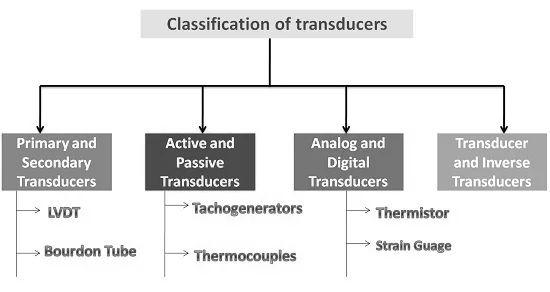Analog transducer Vs Digital transducer-Difference between Analog transducer and Digital transducer
This page compares Analog transducer Vs Digital transducer and mentions difference between Analog transducer and Digital transducer.
Analog transducer
Definition:
The transducer which converts input quantity into analog output is called
analog transducer. Analog output refers to continuous output with respect to time.
Example:
• LVDT
• Strain Gauge
Digital transducer
Definition:
The transducer which converts input quantity into output having digital pulses
is called digital transducer.
Example:
• Shaft Encoders

The transducers can be classified as per figure-1 above into following types.
• Active and passive
• Analog and digital
• Primary and secondary
• Transducer and inverse transducer
Transducer Related Links
Difference between sensor and transducer
Difference between active transducer and passive transducer
Difference between primary transducer and secondary transducer
What is difference between or comparison between
Following links mention difference or comparison between various equipments and terms:
comparison between SPI and I2C
difference between PXI and PCI
Microscope vs Telescope
Amplitude Modulation vs Angle Modulation
difference between modem and router
Air Fuel Ratio Sensor vs O2 Sensor
Radiometer vs Spectrometer vs Spectroradiometer
Clamp meter vs digital multimeter
Colorimeter vs Spectrophotometer
difference between Prism and Grating
difference between Venturi meter and Orifice meter
difference between Lux and Lumens
